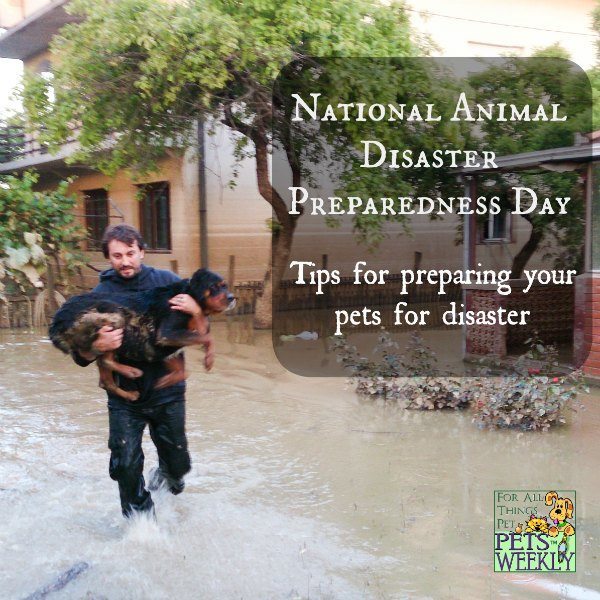National Animal Disaster Preparedness Day
Share

 We’ve spent time discussing how to prepare pets for disasters by creating a “Bug-Out Bag” in case you ever found yourself in a situation where you needed to get out, and get out quick. Now spring has fully sprung, and the second Saturday of May is National Animal Disaster Preparedness Day.
We’ve spent time discussing how to prepare pets for disasters by creating a “Bug-Out Bag” in case you ever found yourself in a situation where you needed to get out, and get out quick. Now spring has fully sprung, and the second Saturday of May is National Animal Disaster Preparedness Day.
If any of you remember the sad images of human and animals alike stranded on rooftops after Hurricane Katrina, then you’ll understand why it’s so important to not only prepare for the human members of your family, but for your pets as well.
Ready, launched by the Federal Management Emergency Agency (FEMA) back in 2003, is a national public service announcement campaign designed to educate the citizens of the United States on how to prepare and respond to national emergencies.
The Ready website has a wealth of information to peruse, and they didn’t leave pets out. Read over some of the most important advice on pet disaster preparedness below, and then go to the Ready website for the full scoop.
[heading style=”1″ color=”#ff9933″ style_color=”#ff9933″]Don’t leave your pets behind.[/heading]
In the event that evacuation becomes necessary, take your pets with you. Their chances of survival are slim if you leave them behind, and if they do survive, you may not be able to find each other again when you come back home. While you’re planning how you and your family will evacuate if necessary, include pet transport and supplies in your plan.
If your pet has problems getting in and out of crates or with whatever you use to secure your animal in the vehicle: practice, practice, practice. This will take the stress out of the activity so that it’s completely routine if you ever need to get them in the car in a hurry.
[heading style=”1″ color=”#ff9933″ style_color=”#ff9933″]Get a “go” or “bug-out” bag ready for your pets.[/heading]
We have discussed Preparing Your Pets for Disasters: The Bug-Out Bag which discusses how to create a Go-Bag (aka, “Bug out Bag”). Know what you should include in the bag for each of your pets.
Make sure your bug-out bag includes water, food, vet records, tools for handling pet waste, grooming wipes, and medicines. Check the article above and the Ready website for more detailed lists.

[heading style=”1″ color=”#ff9933″ style_color=”#ff9933″]Have A Backup Plan.[/heading]
What would you do if you were unable to get back to your house to evacuate your pet? The Ready site suggests having a buddy system with a neighbor who will evacuate with your pet if you can’t come back.
We think it’s a good idea to have at least two different people who will help you (and you them) get your pets to safety if needed. This may include yourself and a family member or neighbor, or even a pet-sitter you have on call for emergencies. (Learn How to Choose A Boarding Facility or Pet Sitter).
Make sure the people included in any back-up plans have access to your home and are comfortable with your pets – including getting them secured in their automobiles.
[heading style=”1″ color=”#ff9933″ style_color=”#ff9933″]Check with Local Shelters.[/heading]
Most emergency shelters do not allow pets.
Make sure you check with your local shelters before including them in your planning.
To find your nearest emergency shelter, text SHELTER + your ZIP code to 43362 (4FEMA) to find the nearest shelter in your area. (For example: shelter 12345).
If you have to go to a shelter, this would be a good time to fire up the back-up plan. Call your vet and local animal shelters for advice and information – they may be aware of places or procedures specific to your area.
[heading style=”1″ color=”#ff9933″ style_color=”#ff9933″]Make it easy for others to know your pet is yours.[/heading]
If you don’t have one already, snap a “Family photo” with your pet, as well as detailed photos of your pet with their specific markings. Put printed copies of the photos in your pet’s bag and in your own wallet.
Put stickers on your pet’s carrier with your name and phone number. Include a phone number for a relative or neighbor as well, but be sure to check with the person you choose as an alternate contact so they’re aware that they may be contacted by officials and expected to care for your pet.
It isn’t exactly pleasant to prepare for the possibility of bad things happening, but the bottom line is that you should prepare. It doesn’t take long to get everything organized, and practicing will cost you roughly 15 minutes every now and again. You’ll be mighty thankful you are already prepared if you had to get out of the area within the hour, when there’s no time to run around, and the cat is freaking out and hiding under the bed. Everyone grabbing their stuff and getting the pets set like a well-oiled machine is a much better option.
Click here to get the printer-friendly “Information for Pet Owners” guide from Ready.
FEMA also has a great video about preparing your pets for disaster and we strongly suggest you watch it.
[box title=”Read more about Disaster Awareness and Planning for Pets:” box_color=”#ff9933″]- 6 Ways to Keep Dogs Entertained During Disasters
- Preparing Your Pets for Disasters: The Bug-Out Bag
- Keeping You and Your Pets Safe Without Power in Winter
- Keeping Pets Safe Without Power in Summer
- Checklist for Pet Safety During Storm









